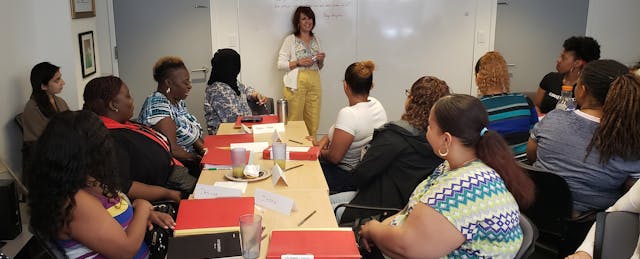Eight preschoolers transitioned from play time to circle time. As the children began to take their places on the rug, one little boy refused to leave his blocks. The tell-tale signs of a temper tantrum began. Angela Terrero, a teacher assistant, approached him calmly with a visual cue in hand—a picture of a group of children sitting in chairs, which our non-verbal students recognized as “circle time.” She gently talked the little boy through putting his blocks away, and persuaded him to follow her back to his friends. Tantrum averted.
Communicating with non-verbal children is not a new task for Tererro, who has a young daughter with Autism. However, a year ago she would not have known how to use a visual cue to engage a non-verbal child. In fact, a year ago, she wasn’t even a teacher. The demands of raising her daughter made it challenging for Terrero, who has a high school education, to find stable work that fit her child care schedule. She worked part time at a beauty salon for awhile, but her child care needs were too high, so she had to quit her job and was unemployed.
But last year, Terrero enrolled in our Grow Your Own Workforce Development Program (GYO), which is designed to recruit and retain new early childhood educators in New York City. The program exposed her to strategies for working with children with special needs, which she is now applying both at home and in her new role as a certified teacher assistant at the Kennedy Children’s Center, a public special education preschool in New York City. She is prepared to meet the needs of her students and is determined to enroll in college next year to become a certified special education teacher.
As the executive director of the Kennedy Children's Center, Terrero’s story fills me with pride and hope for cultivating a new generation of preschool teachers. One of my biggest challenges is finding teachers who are qualified to work with our unique population of nearly 400 3-to-5-year olds. The children we serve have a range of developmental delays and diagnoses, including more than half who have been diagnosed with autism spectrum disorder. All students in our program have Individual Education Plans (IEPs) that specify learning goals and services that our staff members are responsible for delivering—but the reality is that there is a significant shortage of early childhood special education teachers and teacher assistants who are qualified to do this demanding work.
Difficulty Finding and Retaining Teacher Assistants
To be successful with the population of learners our school serves, our teachers must be experienced with language facilitation, behavior management and curriculum differentiation. Research shows that educators who are trained in the above areas and who have a deep understanding of how the developing brain learns are more responsive to their students’ needs and able to optimize student development.
Each of our classrooms has one teacher and two teacher assistants serving classes of six, eight or twelve children, depending on their needs. At our school, teacher assistants represent 40 percent of the teaching staff, which also includes specialists who provide related therapy services. Without well-trained teacher assistants and certified special education teachers, students do not receive the support they need and that we are legally required to offer as a provider contracted by the New York City Department of Education.
As the national teacher shortage continues to disproportionately affect the children we serve, who are primarily low-income and bilingual, we increasingly rely on teacher assistants going back to school to become certified teachers. In fact, 40 percent of our teachers began as teacher assistants. They have the experience, the passion and a sincere desire to give back to their communities. But it’s hard to find teacher assistants for our program. And even when we find them, it’s hard to keep them. Like most early childhood centers, we experience a 30 percent annual turnover rate among teacher assistants.
There are good reasons for this. Early childhood educators receive low pay and have high stress, and the stress is typically higher for early childhood educators serving children with special needs. Teacher assistants are often unprepared to address challenging behaviors and to implement strategies that support learners in meeting the goals on their IEP. That preparation is important when you’re trying to soothe a child who is upset that the lights are too bright, modifying a lesson to accommodate a student who has little language or helping a child play with friends in the block center. Newly hired teacher assistants are often overwhelmed by the demands of the job and our students’ high level of needs.
Developing a Pipeline of Trained Teacher Assistants
In 2018, we decided to do more to tackle this systemic problem by launching the Grow Your Own program with funding from the Robin Hood Foundation. The six week program has one full-time, paid staff member. In addition, members of Kennedy Children’s Center’s executive management team—including myself—contribute to the program, mostly by leading workshops. All of the training takes place during school hours so that teachers’ time mentoring GYO participants is compensated as part of their regular salaries. In-class experience makes up about 30 percent of the program. The remainder includes professional development sessions, mandated state training and job search preparation.
Our goal was to recruit a diverse cohort of aspiring teacher assistants and design a program that went beyond certification exam preparation to prepare them for what they’ll encounter in special education classrooms. GYO exposes participants to the science of early learning through workshops, videos, coursework and facilitated discussions about how participants can apply their learning. In addition to preparing them for what to expect on the job, our program helps participants build the skills needed to successfully obtain a teaching assistant job in early childhood centers like ours, so we include coaching on workforce skills such as resume-writing and interviewing. We hoped that by doing so, we might increase the number of teacher assistants in the system and cultivate a pipeline of aspirants for certification as fully certified special education teachers.
Over the last two years, we’ve recruited 100 individuals in partnership with community workforce programs. Of those 100 recruits, 82 completed the program and about half of the graduates are currently employed as teacher assistants. Of the first cohort of GYO graduates, 71 percent reached three-months of employment and of the 25 graduates that we hired ourselves, 76 percent are still with us one year later.

Terrero, is one of our GYO graduates and she is thriving in her new career. The program offered her an opportunity to support preschoolers and their families in the Bronx, the borough she calls home, and her teaching schedule matched her daughter’s school hours, so she was able to care for her own child.
Terrero told us, “I’ve found my purpose. I was meant to be in this field.”
It’s too soon to fully evaluate the program, but these early results are promising. Numerous preschool directors have contacted me to find out how they can recruit GYO graduates into their schools. To make a greater impact, we need to scale the program and build capacity in other communities. Our current model is limited by the number of staff we have, the number of classrooms available for on-the-job training and the fees associated with certification. Expansion will require a community effort that is funded and supported by local school districts, the state education department and other private foundations.
By recruiting more teacher assistants like Terrero to serve our most vulnerable learners, we can build a diverse, passionate, well-trained workforce. A strong team of teacher assistants is key to the success of an early childhood program and an investment in their professional growth is good for children, families and communities. Reimagining an early childhood teacher pipeline starts by building a strong foundation of teacher assistants who can become the fully certified teachers we need now and in the future.


